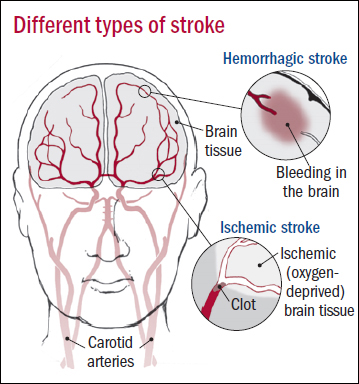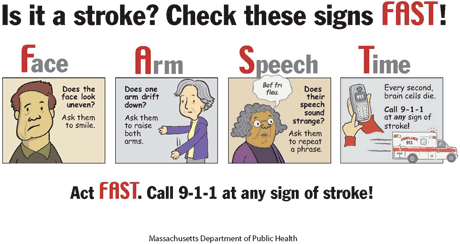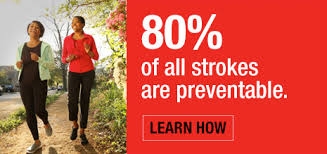Strokes: Recent research advances for future treatments
Submitted by Ivelisse Cruz Torres on
A stroke is a cerebrovascular incident in which there is a lack of oxygen being supplied to the brain. There are local ischemic strokes, where a clot blocks a blood vessel and hemorrhagic strokes, which occur due to the rupture of a blood vessel.1 Although local ischemic attacks are more prevalent (85% of cases) both cause massive neuronal death in the affected area, called the core, and less extensive neuronal death in adjacent areas, called the penumbra.

Strokes are the second leading cause of death worldwide and affect around 795,000 people in the United States.2 Cerebrovascular diseases are the fifth leading cause of death in Puerto Rico, only surpassed by diseases such as cancer, heart disease, and Alzheimer's disease.
It is estimated that in 2012, in Puerto Rico, the mortality from cerebrovascular disease was 36 women and 38 men per 100,000 people. Recently an increase in the prevalence of stroke patients between the ages of 45-64 in Puerto Rico has been reported.3
Although there are no statistical differences reported between genders in Puerto Rico regarding incidence, strokes occur more frequently in men, but the incidence levels in women increase after they reach menopause.4 This difference is attributed in part to the presence of sex hormones such as estrogen which provide a level of protection in women.5 These hormones reduce the risk of stroke and decrease the damage to brain tissue as a result thereof, according to scientific studies on animals.6.7
Usually, patients with stroke show signs such as numbness in the head, arms or legs, and slurred speech, sometimes accompanied by confusion. These signs can be used to identify a person who has suffered a stroke (Face, Arms, Speech, Time - FAST).8

The existing treatment in case of a stroke is the administration of tissue plasminogen activator (tPA), which acts as an anticoagulant, diluting and reducing the clogging of blood vessels that supply oxygen and nutrients to the brain. This treatment is effective only if injected within the first 3 to 4.5 hours after the stroke occurs. That is why it is crucial to know how to identify the symptoms of a stroke as quickly as possible.
Patients who survive a stroke often experience persistent memory problems and cognitive deficits. These arise from a number of cellular processes such as oxidative stress, toxicity caused by neuronal excitation, apoptosis (programmed cell death), and excessive immune system responses that affect sensory brain regions.
Currently, scientists use animal models to transiently obstruct the flow of oxygen to the brain and thus identify the cellular mechanisms that have been altered as a result of a stroke.9 In this way, they can study and evaluate the effects of blocking or stimulating the altered mechanisms. These cellular processes could then be used as targets to develop therapeutic strategies to ultimately help people who experience strokes.
One of these strategies is neuronal protection. One of the cellular mechanisms for neuroprotection that have been considered as promising recently are the interleukins, which can act as both pro-inflammatory and anti-inflammatory signals. Certain interleukins that act as anti-inflammatory factors have been shown to reduce damage to neural tissue in animal models.10
Another strategy being studied is to decrease the toxicity caused by Reactive Oxygen Species (ROS), which accumulate due to excessive excitation of neurons, low oxygen levels, and lack of cellular respiration produced by the mitochondria. There are multiple sources of "ROS" including enzymes that produce these reactive oxygen species under normal physiological conditions and increase their output when a stroke occurs.
Developing treatments to reduce the levels of these ROS or their direct neutralization can help reduce neuronal cell death. Another strategy would be to enhance the activity of antioxidants or modulate the activity of the enzymes that synthesize the reactive oxygen species in order to regulate their level in the cells.11 Additionally, blocking the receptors that cause excessive neuronal excitation may reduce ROS and in turn prevent cell death.
Also, targets located in the barrier between the brain and the blood vessels, which generally maintain a separation between the systemic circulation and selective flow of nutrients that enter the brain, known as the Blood Brain Barrier (BBB), have been identified. Some enzymes (metalloproteinases), for example, are upregulated as a result of a stroke, causing the destruction of components of the BBB and allowing greater access of molecules to the brain, which may be harmful in many cases.13 Blocking these enzymes will prevent loss of BBB integrity and may reduce injury effects.
The study of strokes has largely shown that the condition involves complicated cellular mechanisms. Recent scientific efforts point to promising interventions to combat the adverse effects associated with reperfusion, the return of blood to the affected area of the brain, thus protecting the neuronal tissue after a stroke.
However, few therapies currently exist to reduce the impact of stroke injury. Therefore, lifestyle changes and increased awareness of stroke symptoms remain the best first-line of defense against the devastating impact of stroke.
The author is a doctoral student in the Department of Pharmacology at University of Colorado Anschutz Medical Campus and a Yale Ciencia Academy Fellow.
References:
-
Levine SR. Pathophysiology and Therapeutic Targets for Ischemic Stroke. Clin. Cardiol 27, II12–II-24 (2004)
-
Appelros P. Sex differences in Stroke Epidemiology. Stroke 40, 084-1090 (2009)
-
Alonso de Leciñana et al. Risk of Ischemic Stroke and Lifetime Exposure to Estrogen. Neurology 68, (1) 33-38 (2007)
-
Alkayed NJ et al. Gender-linked Brain Injury in Experimental Stroke. Stroke 29, (1) 159-165 (1998)
-
Alkayed NJ et al. Neuroprotective Effects of Female Gonadal Steroids in Reproductively Senescent Female Rats. Stoke 31, (1) 161-168 (2000)
-
Herson PS and Traystman RJ. Animal models of stroke: translational potential at present and in 2050. Future Neurology 9, (5) 541-551 (2014)
-
Wang J. Inhibition of Soluble Epoxide Hydrolase After Cardiac Arrest/Cardiopulmonary Resuscitation Induces a Neuroprotective Phenotype in Activated Microglia and Improves Neuronal Survival. J Cereb Blood Flow Metab 33, (10) 1574–1581 (2013)
-
Radermacher KA et al. Neuroprotection After Stroke by Targeting NOX4 As a Source of Oxidative Stress. Antioxidants & Redox Signaling 18, (12) 1418-1427 (2013)
-
Jia J et al. Sex differences in neuroprotection provided by inhibition of TRPM2 channels following experimental stroke. J Cereb Blood Flow Metab. 31, (11) 2160–2168 (2011)
-
Zeng X et al. Acute ethanol treatment reduces blood–brain barrier dysfunction following ischemia/reperfusion injury. Brain Research 1437, 127–133 (2012)
14. Wang Z et al. Doxycycline-Mediated Protective Effect Against Focal Cerebral Ischemia–Reperfusion Injury Through the Modulation of Tight Junctions and PKCδ Signaling in Rats. J Molec Neurosci 47, (1) 89-100 (2012)










